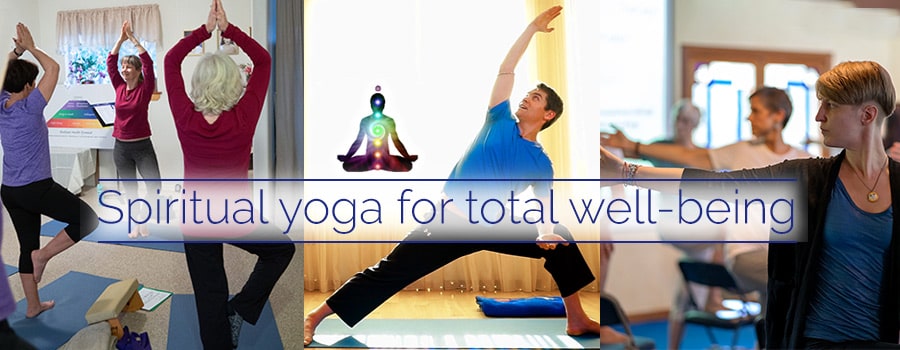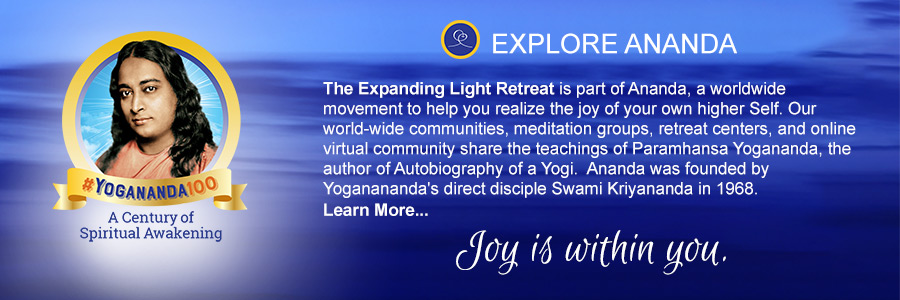Bhakti Yoga — The Yoga of Devotion
Part 2 of Asanas Can Teach Us the Deeper Side of Yoga
Bhakti Yoga is about creating a dynamic flow of energy from the heart chakra toward the object of one’s longing.
It is not a sentimental or sappy kind of love; it is pure, strong, one-pointed and calm. The heart becomes the vehicle through which the soul unites with the object of worship.
Some people don’t consider themselves naturally devotional and therefore feel Bhakti Yoga to be irrelevant to their practices.
However, devotion is a central to everyone’s spiritual life; we can and should develop it. In his book, The Holy Science, Sri Yukteswar, whom Paramhansa Yogananda described as a gyanavatar (incarnation of wisdom), gave a highly scientific, esoteric, and intellectually challenging presentation of the history of yoga and the nature of man.Nevertheless, he concluded by saying that all that really matters is love! So you see, even a gyana yogi testifies as to the all-importance of cultivating the natural love of the heart.
One reason that devotion is so important is that it can take us beyond technique. Eventually we realize that neither intellectual knowledge of yoga nor outward practice is enough. We crave the inner experience, the intuitive perception that is felt in the heart.
How can we cultivate devotion? The ways are as diverse as the individuals who seek it. Below are some suggestions that I hope will help you and your students. But remember, there is no prescribed formula. As Lord Krishna says in the Bhagavad Gita, “Even a flower or a leaf, offered with devotion, is acceptable to me.” Ask yourself, “What awakens devotion in me?” — and proceed accordingly.
Putting the Heart into Asana
It can be very helpful to bring your practice of Bhakti Yoga into your classes — both for your sake and for the sake of your students.
Before class, meditate and center in your heart. Pray to be guided in devotion, to feel the heart’s natural longing for deeper meaning and experience. Pray for your students, that their hearts may be opened. If your class setting permits, invite your students to join in an opening prayer, aloud or silently.
Even newcomers can benefit from this. Recently, a first-time student came up to me after class and said, “I’ve received just what I needed to help set the tone for the corporate training sessions I’m leading.” Her own openness and heart-centeredness had been awakened, showing her how to help others have a similar experience — even in the environment of big business!
One of my favorite Hatha Yoga quotes by Swami Kriyananda is “The yoga postures are the outward expressions of the inner movements of the soul.” This gives us profound insight into how to develop devotion through Hatha Yoga. The yoga postures are like a dance, a form of worship, or an arati (a traditional Indian ceremony that involves waving a lighted lamp before an altar, as in Ananda’s Festival of Light).
Consider surya namaskar (sun salutation). The flow of movements that comprise this asana sequence are like a dance; coordinating them with the breath encourages fluidity and grace.
The very word “salutation” connotes an act of honoring, of reverence. When we begin by placing the palms together (“pranam position”) at the heart, our attention is drawn there. With just a little effort, we can start to generate a current of energy in the heart.
In all the asanas, draw your students’ attention to how they move their bodies. Remind them to bring what they want to experience into what they’re doing — rather than waiting for it to happen “magically.” Ask them to initiate every movement from an awareness in the heart, to be motivated by love and the desire to live more in the heart.
At first, this may feel artificial to some students, but with practice, it will soon become their actual experience. You can help speed this process by reminding them of this important truth: “If you want to feel grace, move with grace. If you want to be more heart-centered, connect with that part of your body so you can feel your energy there. Practice the asanas from a center of awareness in the heart.”
Here’s another way to help students experience this: In trikonasana (triangle pose), start with the hands at the heart in pranam position. As you inhale, extend your hands out in front (still in pranam) and then open to the side, thus physically expressing a heart expanding and opening. Stay in this position for a few moments to feel the fullness of the heart before moving into the actual pose.
An Inner Offering

Another posture that helps cultivate an inner offering of the heart is the yoga mudra, the “symbol of yoga.” Its affirmation — “I am Thine; receive me.” — emphasizes two important elements of Bhakti Yoga.
The first is self-offering. Selfless love is one of the quickest ways to relinquish the desires of the heart that keep us from Him.
While inwardly affirming “I am Thine,” think of God in personal, human terms: as Father, Mother, Friend, Beloved. Such a personal view can help you awaken and direct love toward God. In my classes, many students have found this very helpful and personally inspiring. If your class setting doesn’t allow you to guide students in this way, still, if you practice it yourself, the benefits will spill over to them.
The second important aspect is listening. While affirming “Receive me,” consciously listen for a divine reply. Your ability to listen is enhanced by releasing tension in the body and in the heart; breathe it out of the body. Focus in the heart, feeling it as a powerful magnet drawing the Divine into your life.
Another way to cultivate an attitude of sacredness is to use the Sanskrit names for the asanas. The vibration of Sanskrit can help you think devotionally, more in the bhav (spiritual mood) of true yoga. Students often report that it helps them, too. It’s well worth the small investment of time and effort required. (Of course, do this only if it feels appropriate and your motivation is sincere, not born of a desire to impress your students.)
Breathing Techniques and the Heart
Because breathing is governed by the heart chakra, breathing techniques are powerful tools for becoming more heart-centered. They directly influence prana (“life-force”), giving us some control over it; hence they’re often called pranayama (“energy control”) techniques. But remember: breathing techniques are less about breathing and more about heightening our awareness of the life current, directing it, and ultimately controlling it.
Pranayama is often overlooked in yoga classes. To the untrained eye, focused on the goal of “a good workout,” pranayama seems but a filler. However, it can be invaluable for opening the heart, for it helps students become still and relaxed. Only then will they feel comfortable enough to open their hearts. (To test this statement, observe yourself the next time you feel agitated or upset. You’ll see that it’s very difficult to be open and to lead with your heart.)
In Ananda Yoga® we begin with pranayama to help calm and center our being. Of course, some students may initially resist this “slowing down,” but as they breathe consciously, relaxation seeps in. And as they relax, the energy starts to move upward, more naturally centering in the heart.
Creating a Heart-Full Outer Environment
Although I’ve been talking about inner matters, the outer environment of your class is also important for the heart — and no matter where or who you teach, you can influence that environment. Think creatively — you’ll be amazed at what you can do.
Obvious touches that come to mind are incense (provided students aren’t sensitive to it), harmonious music, soft lighting, candles, soothing colors. Green, for example, is associated with the heart center.
Also consider personal hygiene. You may be physically clean, but did you just run in from your other job or a hectic day? If you have the option, a shower can do wonders by minimizing body consciousness, making it easier to lift your awareness to the heart center. (By the way, end your shower with cold water; Paramhansa Yogananda said it helps to magnetize the body.)
Consider your clothes, too. I have clothes that I only use for my asana practice. They have a particular vibration, and I feel that in a small way they help support overall harmony. It’s the same with a personal yoga mat and blanket. Everything has a vibration, and these vibrations can subtly support — or hinder — movements of energy upward to the heart.
Bring Heart Energy into Your Voice
According to the ancient teachings of India, the most perfect of all human instruments is the human voice. No other instrument expresses so perfectly the nuances of thought and feeling.
For this reason the voice is a very powerful tool for helping us connect with the energy of our heart. As the Bible says, “Out of the fullness of the heart, the mouth speaketh.”
As a teacher, your voice does more than just lead others; the vibration of your speech affects your students. Concentrate, therefore, on projecting a positive tone and vibration in your voice. It’s a challenge to be this aware, but it develops naturally as you focus on living more from within.
In fact, it’s said that one of the early signs of progress in yoga is a growing sweetness in the voice. You can also develop the voice by using it in more naturally devotional practices, such as singing or chanting. As you use music and your voice to express the love of your heart for Divine Mother, your voice will change and take on the energy of the expanded heart.
Your students, in learning to use the asana affirmations deliberately and with feeling, will discover the relationship between the voice and energy. If they repeat the affirmations from an awareness in the heart, they will receive added support for their practice.
Of course, not every affirmation is about “heart qualities”; however, effective affirmation always requires feeling the quality you’re affirming, and your feeling capacity is centered in the heart. For this reason, it can be helpful occasionally to invite your students to repeat the affirmations aloud and with devotion or longing. After all, these affirmations represent states of consciousness that everyone longs to possess, and that longing comes from the heart.
Project Outward from Your Heart
One of the most powerful ways to open the heart is to invite others in. The affirmation for the half spinal twist (ardha matsyendrasana) — “I radiate love and goodwill to soul-friends everywhere” — is a perfect vehicle for this.
Encourage your students to use it consciously to expand their bubble of joy to include others. Tell them that if at first this seems difficult or insincere, be patient. As they proceed in their practice, deepening relaxation will so soothe and melt their hearts that this outflow of love will happen naturally.
Similarly, when you finish your practice or your class, share your joy, your love, with everyone. Send out vibrations of unconditional love to all. At The Expanding Light Retreat, meditations usually end with healing prayers to share with others in need.
Although your students may be unfamiliar with this practice, most will recognize the truth behind it. You can even offer it as a mental exercise — with no raising of the arms or chanting “AUM” — in order to give students space to respond according to their own inclinations.
The Goal of Devotion is Calmness
Emotion, too, is felt in the heart, but when it is spiritualized, emotion becomes devotion. Devotion is a refinement of the heart’s energy. It lifts our souls heavenward until we become one with God.
As Swami Kriyananda wrote in The Art and Science of Raja Yoga:
“Those true saints in all religions, no matter how eagerly they prayed, sang, or danced in their devotion, reached a point in their development where deep inner calmness took over. All movement ceased.
“Saint Teresa of Avila reported that in this state she could not even pray, so deep was her inner stillness. Truly, she was a yogi though she had never heard of yoga. But because she was not aware that such perfect stillness is the goal of the spiritual search, she wasted many years (as she later stated) in trying to force her mind to return to superficial devotional practices which the soul was endeavoring to transcend.”
In light of the experience of those who have gone before us, we must realize that even our Hatha Yoga practice, which we so love, will someday fall by the wayside, giving way to perfect stillness and inner communion.
You can hasten that “someday” by letting your practice be motivated by love: Love what you’re doing! Love what you’re sharing with others! Love the science of yoga and the divine art of Self-discovery!
Related Articles
All authors are graduates of Ananda Yoga Teacher Training.





















